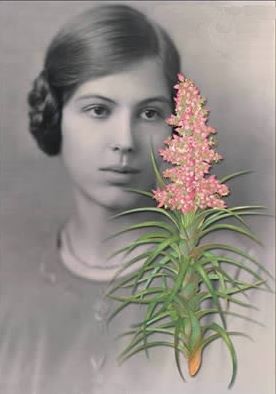
As an ex-student in the School of Plant Science of the University of Tasmania, I was inducted through a training ground, a first year botany laboratory, which bore the name of Winifred Mary Curtis. Then later when my pursuit of botany became more specialized, in the form of looking at bryophytes (mosses and liverworts), I had the privilege of staring down the very same microscope that Winifred Curtis used. But who was this lady centurion who had touched generations of botanists before me, and whose influence is still felt today by participants of the Tasmanian botanical culture, through her forever immortalized magnum opus on Tasmanian Plants, The Student’s Flora of Tasmania.
Winifred was born 15 June 1905 in London, the only child of Herbert John Curtis and Elizabeth Winifred Curtis (née Baker). She studied science at University College, London from 1924, winning various awards and scholarships and ultimately completed her undergraduate studies with an honours degree in 1928.
In 1939 she emigrated to Australia with her family and initially worked as a science teacher at a private girls’ school in Hobart. Later, she joined the Department of Biology at the University of Tasmania and was part of the pioneering team that established the Department of Botany there in 1945. On that account alone, she is indisputably the matriarch of Tasmanian botany. In 1943 she started work on The Students’ Flora of Tasmania, the standard text which superseded
Leonard Rodway’s Flora of Tasmania, and which remains frequently used reference. From the early 1960s much of the work on the Student’s Flora involved a close collaboration with botanical collector and artist Dennis Ivor Morris (1924 – 2005).
Concurrently, Winifred was also interested in the genetics and cytology of plants. In 1944 she published a milestone piece of work on the Variations in
Pultenaea juniperina, which represented the first record of polyploidy in an Australian native plant. This led to her PhD from London University which was awarded in 1950. Her doctoral thesis was titled Studies in Experimental Taxonomy and
Variation in Certain Tasmanian Plants which was a pioneering work in cytology and polyploidy. Her published works on the topic were later sent to the University of London for which Winifred received a Doctor of Science degree in 1968.
During her stint in the Department of Botany, she rose through the ranks to become a Senior Lecturer in Botany in 1951 and later a Reader in Botany in 1956, the most senior position held by a woman at the university at that time. She also acted as Head of the Department on several occasions.

Richea Xcurtisiae (Hybrid Candleheath)
Dr. Curtis retired from the Department of Botany in 1966 and was appointed Honorary Research Fellow; she was made an Honorary Research Associate in the Department of Plant Science in 1998. Retirement did not stop Winifred from working. From 1967 to 1978 she wrote the six-volume The Endemic Flora of Tasmania, a classic in Tasmanian botany features sublime illustrations by botanical artist Margaret Stones. In the late 70s, she was instrumental in setting up the Tasmanian Herbarium at the locality it currently stands in Sandy Bay, in proximity of the Plant Science Department of the University of Tasmania. Also, the final volume of the Student’s Flora on monocots (grasses, lilies and related plants) was also published in 1994, 30 years after she retired, and over half a century after the commencement of the Student’s Flora series.
Winifred Curtis lived to the ripe age of 100 and died on October 14, 2005.
The legacy of the matriarch of Tasmania’s botany lives on in the leading botanists of today, most of which were her students or students of her students and her name has also been immortalized in plants such as Richea x curtisiae, Epacris curtisiae and Epilobium curtisiae.
If I should have any regrets of my time in the School of Plant Science, it would be that I never got to meet Dr Curtis. I must be content however for the vast scope of her work; the Curtis award that continues to be bestowed on generations of first year botanists (of which I was a lucky recipient); and the privilege to have looked through the lens she had used on the plants she lovingly studied.
Further information
http://www.utas.edu.au/library/exhibitions/winifred_curtis/
About David Tng
I am
David Tng, a hedonistic botanizer who pursues plants with a fervour. I chase the opportunity to delve into various aspects of the study of plants. I have spent untold hours staring at mosses and allied plants, taking picture of pollen, culturing orchids in clean cabinets, counting tree rings, monitoring plant flowering times, etc. I am currently engrossed in the study of plant ecology (a grand excuse to see 'anything I can). Sometimes I think of myself as a shadow taxonomist, a sentimental ecologist, and a spiritual environmentalist - but at the very root of it all, a "plant whisperer"!



Pingback: Leonard Rodway, the founder of Tasmanian botany :: Tasmanian Plants